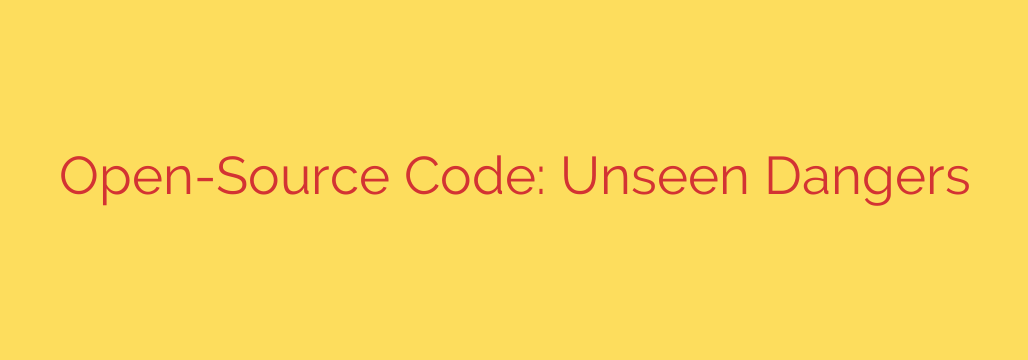
The Double-Edged Sword: Unmasking the Hidden Dangers of Open-Source Code
Open-source software (OSS) is the bedrock of modern technology. From the operating system on your server to the smallest JavaScript library powering a website, free and publicly available code has accelerated innovation at an unprecedented scale. Its collaborative nature allows developers to build faster, stand on the shoulders of giants, and avoid reinventing the wheel.
But this convenience comes with a hidden cost. The very openness that makes OSS so powerful also creates unique and often overlooked security vulnerabilities. Relying on code written by a global, often anonymous community of developers introduces a complex chain of trust that can be easily exploited by malicious actors.
The Software Supply Chain: A Fragile Chain of Trust
Think of your application not as a single creation, but as an assembly of hundreds, or even thousands, of different parts. You may have written the core business logic, but you likely pulled in dozens of open-source packages for everything from handling dates to making network requests. Each of those packages, in turn, has its own set of dependencies. This intricate web is known as the software supply chain.
The danger lies in its complexity. A vulnerability in any single, obscure dependency, no matter how small, can compromise your entire application. Security is only as strong as the weakest link, and in a modern software project, there are countless links you don’t directly control or even see.
Common Threats Lurking in Your Dependencies
While the benefits of using pre-built components are clear, the potential threats are often less visible. Understanding these risks is the first step toward building a more secure development lifecycle.
- Known but Unpatched Vulnerabilities: This is the most common threat. A security flaw is discovered in a popular library, a patch is released, but organizations are slow to update. Attackers actively scan for systems running outdated, vulnerable versions of packages. Failing to regularly update dependencies is like leaving your front door unlocked.
- Malicious Code Injection: A more sinister threat involves bad actors intentionally contributing malicious code to an open-source project. They might gain maintainer status on a small but widely used library or submit a pull request that seems helpful but contains a hidden backdoor. In other cases, they upload “typo-squatted” packages with names very similar to popular ones, hoping a developer makes a mistake during installation.
- Protestware and Sabotage: A growing trend involves developers intentionally sabotaging their own popular packages to protest political or social issues. This “protestware” can introduce destructive bugs, delete files, or display disruptive messages, causing chaos for every project that depends on it.
- The Peril of ‘Abandonware’: Many open-source projects are maintained by one or two dedicated individuals. If they move on, the project becomes abandoned. These unmaintained packages often remain in use for years, becoming ticking time bombs as new vulnerabilities are discovered but never patched.
How to Protect Your Projects: A Proactive Security Strategy
Avoiding open-source software is not a realistic option. The key is not to reject it, but to manage it with a security-first mindset. By implementing a few critical best practices, you can significantly reduce your risk exposure.
Implement Software Composition Analysis (SCA): You cannot protect what you cannot see. Use automated SCA tools to scan your codebase and create a full inventory of every open-source component and its dependencies. These tools cross-reference your list against known vulnerability databases, alerting you to immediate risks.
Automate Vulnerability Scanning: Don’t make security a one-time check. Integrate vulnerability scanning directly into your CI/CD pipeline. This ensures that every new code commit and every updated dependency is automatically checked for known security issues before it reaches production.
Maintain a Curated List of Approved Packages: Instead of allowing developers to pull in any package they find, establish a policy for vetting and approving open-source components. Create an internal repository or “allow-list” of libraries that have been reviewed for code quality, license compliance, and active maintenance.
Practice Good Dependency Hygiene: Keep your dependencies up to date. Use tools that can automatically submit pull requests to update packages to their latest secure versions. Utilize lock files (like
package-lock.jsonoryarn.lock) to ensure that every developer and build server is using the exact same version of each dependency, preventing unexpected changes.Vet New Dependencies Thoroughly: Before adding a new package to your project, perform due diligence. Ask critical questions: Is the project actively maintained? Does it have a healthy community? Are issues and pull requests being addressed? How many other popular projects rely on it? A quick background check can prevent you from building on an unstable or insecure foundation.
Open-source software will remain a vital engine for technological progress. Its benefits are undeniable, but so are its risks. By treating your software supply chain with the same rigor as your own code, you can harness the power of collaboration without falling victim to its hidden dangers. In the world of software development, what you don’t know can hurt you.
Source: https://www.helpnetsecurity.com/2025/09/30/hidden-risks-open-source-code-scanning/








